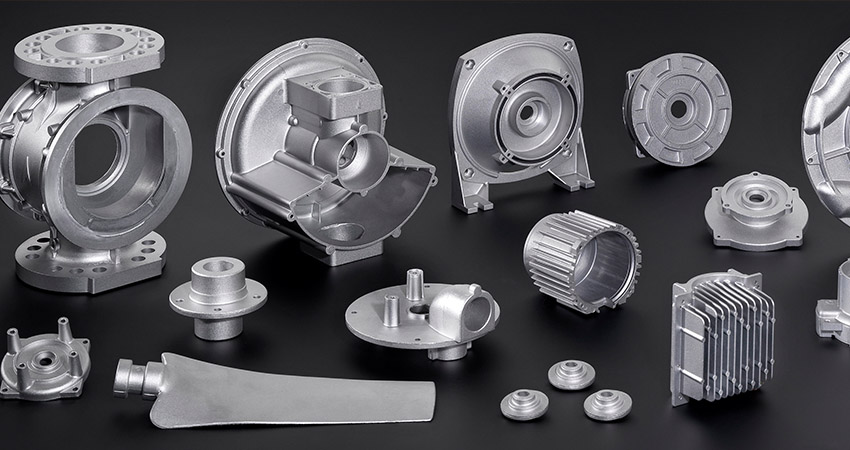Some Known Details About Aluminum Castings Company
Table of ContentsNot known Factual Statements About Aluminum Castings Company The smart Trick of Aluminum Castings Company That Nobody is Talking AboutRumored Buzz on Aluminum Castings CompanyAluminum Castings Company Can Be Fun For EveryoneLittle Known Facts About Aluminum Castings Company.Some Of Aluminum Castings CompanyHow Aluminum Castings Company can Save You Time, Stress, and Money.Aluminum Castings Company Things To Know Before You Get This
There are 2 primary kinds of die spreading used in the light weight aluminum spreading sector: warm chamber die casting and chilly chamber pass away casting. The main difference between these techniques is just how the molten steel is supplied to the mold. In warm chamber die spreading, commonly utilized for reduced melting factor steels, the melting pot is straight connected to the equipment, and a plunger requires the product through a gooseneck right into the die dental caries.
The Basic Principles Of Aluminum Castings Company
In these methods, the mold is intentionally destroyed or damaged away in order to remove the completed aluminum spreading. Typical processes under the group of expendable mold casting consist of (financial investment casting),,, and financial investment spreading. When making customized aluminum parts utilizing expendable mold and mildews, suppliers put liquified aluminum or aluminum alloys into the mold and mildew, which is then damaged apart to release the solidified steel component.
The is one of the oldest and most favored kinds of aluminum casting. It entails compacting specialty factory sand, commonly enhanced with clay or material, around an exactly crafted recyclable pattern that figures out the shape and internal details of the completed light weight aluminum product. The pattern system incorporates risers and vents to take care of the circulation of liquified steel and to avoid casting problems such as contraction porosity.
Some Known Facts About Aluminum Castings Company.

This mold is then preheated prior to the pouring of molten aluminum or aluminum alloy. As the steel fills the shell, it captures the elaborate information and fine surface area finish of the mold. Once cooled, the ceramic is mechanically or chemically escaped, enabling the elimination and splitting up of individual cast parts.
Aluminum Castings Company Things To Know Before You Get This
Long-term mold casting uses reusable steel mold and mildews and is ideal for automation with consistent top quality and much less waste. Expendable mold and mildew spreading utilizes single-use molds, like sand or foam, supplying style versatility and reduced tooling expenses for models or brief runs. Pass away casting is best for producing high quantities of aluminum components that require tight resistances, great details, and smooth surfaces.
The Toshiba Device DC-J Collection consists of die casting machines appropriate for light weight aluminum. Understood for their durable building and high shot efficiency, these equipments guarantee reliable and precise casting (Sand Foundry).

While aluminum can be used in its pure type, it is often alloyed with other metals to improve its residential properties or the properties of the other steels. Aluminum alloys are classified into eight collection, numbered from one to 8.
Aluminum Castings Company - Truths
This alloying boosts the toughness and solidity of aluminum but decreases its ductility and corrosion resistance. The 2000 collection alloys are testing to weld however can be warm treated to enhance their residential or commercial properties. The 3000 series alloys are largely alloyed with click for more info manganese. This mix improves corrosion resistance while giving modest toughness.
The 4000 collection alloys are alloyed with silicon, which decreases the melting point and boosts fluidness. This makes it a prominent choice for spreading, as it is easy to create in its molten state.
Things about Aluminum Castings Company
This series is classified as a high-strength alloy, especially matched for sheet and plate applications because of its superb weldability. Its resistance to corrosion from acids and alkalis makes it excellent for usage in rough and hostile atmospheres (Aluminum Castings). The 6000 collection alloys are alloyed with both magnesium and silicon, giving a balance of strength, mechanical residential or commercial properties, and deterioration resistance
Handling the 6000 collection needs specialized and sophisticated devices, which can be complex and costly. Nevertheless, this series is understood for its excellent deterioration and oxidation resistance, in addition to its ease of finish, treatment, and workability. The 7000 collection light weight aluminum alloys are the toughest and most durable among aluminum kinds, with stamina equivalent to about two-thirds of industrial-grade A3 steel.
Aluminum Castings Company Things To Know Before You Buy
Zinc is the main alloying element in the 7000 series, enhancing the solidity of the light weight aluminum, although zinc's firmness resembles that of light weight aluminum on the Mohs scale. The 8000 series light weight aluminum alloys are mainly alloyed with tin, along with tiny amounts of copper and nickel (Sand Foundry). While these alloys supply reduced toughness contrasted to other series, they master machinability and put on resistance
Aluminum cast heatsinks are electrically conductive, permitting them to be grounded efficiently. They are commonly cast with integrated functions that minimize the requirement for secondary operations, such as added machining or assembly, leading to additional cost financial savings. Aluminum casting is regularly used to produce brackets for both sturdy industrial devices and household devices.
Aluminum Castings Company Fundamentals Explained
The single-piece construction of light weight aluminum braces improves their strength and resilience, reducing the likelihood of failure. If openings are needed, they can be included straight in the spreading mold and mildew, minimizing the requirement for post-production finishing (https://myspace.com/alumnmcstngs1). Makers have actually increasingly adopted aluminum spreading for golf tools because of its sturdiness, security, and flexibility in shaping